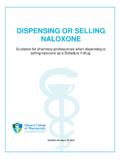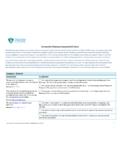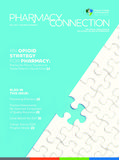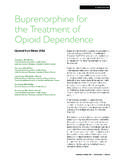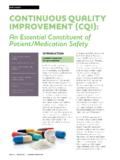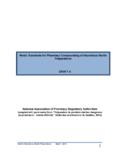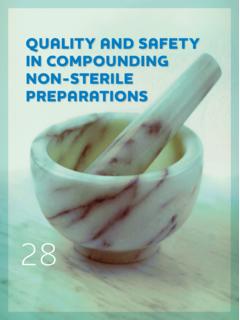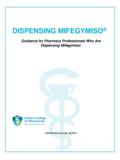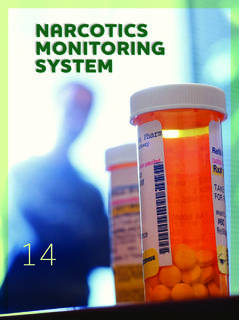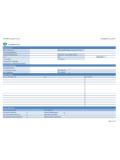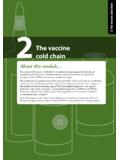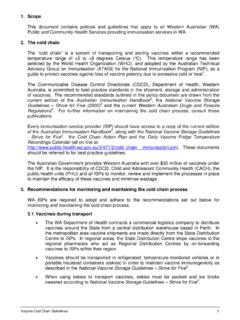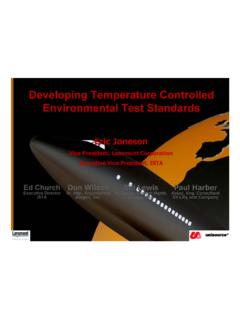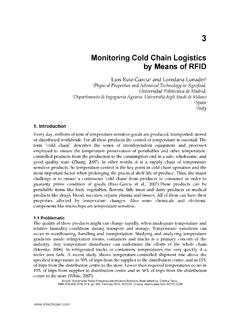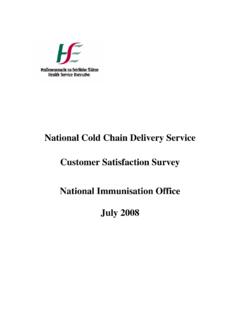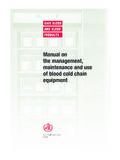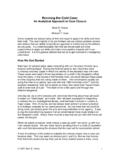Transcription of Protecting the Cold Chain - OCPInfo.com
1 PH!RM!CY CONNECTION ~ SPRING 2012 ~ P!GE 33 The cold Chain is necessary to preserve the potency of substances !hile they are in transit. In addition to tempera-ture, products may also be sensitive to variations in humidity and light, and it is appropriate to include these in the category of those products requiring a cold Chain . Products that have not been maintained at the appropriate tempera-ture and under the appropriate conditions are considered to be unsafe for use. This article !ill provide an overvie! of the legislative and policy frame!ork that governs the safety and security of temperature-sensitive products and a brief introduction to the cold Chain journey, including the issues associated !ith the last mile. Some best practices for protection of cold Chain products in the pharmacy are identified as !ell. "s this is an issue that falls !ithin the accreditation requirements for pharmacies in Ontario, information on the inspection process !
2 Ill also be included. Tips on implementing good cold Chain practices appear in the side bar to this article. p p j Z p "n increasing number of medications require cold Chain protection and it is expected that the number of pharma-ceuticals and biologics that require cold - Chain monitoring !ill continue to increase over the next several years. "ll persons and companies !ho are involved in the storage and trans-portation of drug products, for either human or veterinary use, should be a!are of their responsibilities to keep prod-ucts safe. The federal Food and Drugs !ct and Regulations set out the requirements for the labelling, storage and cold CH!IN! cold Chain is a temperature-controlled supply Chain for products such as pharmaceuticals, vaccines and blood products that require a specific temperature range during distribution and storage. Protecting the cold ChainBy Barbara CadotteSenior Policy Advisor, OCPP!GE 34 ~ SPRING 2012 ~ PH!
3 RM!CY CONNECTION transportation of temperature-sensitive drugs in Health Canada has also provided guidelines to assist fabricators, packagers/labellers, distributors, importers and !holesalers to understand and meet their obligations !hen handling, storing and distributing such The Drug and Pharmacies Regulation !ct establishes accreditation requirements for pharmacies in Ontario, including the requirement for a refrigerator in the dispensary maintained at a temperature bet!een 2 and 8 Celsius to store drugs and other medications requiring The Designated Manager (DM) is responsible for ensuring that all drugs and medications purchased by a pharmacy for use or sale are of an acceptable standard and The DM is also accountable for ensuring that there are appropriate poli-cies and procedures in place to manage the cold Chain once the pharmacy takes custody of the product. #here there is a remote dispensing system operated by the pharmacy, the DM ensures that systems are in place to track the movement of drugs and other medications bet!
4 Een and among the pharmacy and its remote dispensing locations. THE cold CH!IN JOURNEYE nvironmental controls are key to maintaining drug safety, quality and The cold Chain distribution process officially begins !hen a product is released from a manufacturer's !arehouse. From that point on, the cold Chain is a complex series of multiple touch points, facilities, vehicles, modes of transportation, and personnel that ultimately ends !ith the administra-tion of a medication to a In the near future, this may occur at a pharmacy, but generally today this requires additional movement of the medication from the pharmacy to the place of administration, generally a physicians office, other facility or the patient s home. "ll temperature-sensitive pharma-ceutical and biologic products (those that require refrigeration to avoid heat damage, and those that must avoid freezing) are at risk of temperature damage if handled improperly any!here along this journey.
5 ZZ p Vaccination is one of the most effective public health interven-tions for promoting good health and preventing disease, and pharmacists have al!ays played a role in advocating for patient immunization by providing general information and educating patients on risks and benefits, as !ell as by hosting immunization clinics. In both Canada and the United States, the scope of pharmacist practice is moving to!ard medication therapy management and a!ay from the traditional practice of only dispens-ing medications. Several provinces and states have already conferred Category International Storage and Shipping RequirementsFrozen -25 C and -10 CCold !ny temperature not exceeding 8 (in Ontario a pharmacy is required to have a refrigerator !ith a temperature bet!een 2 C 8 C)Cool Bet"een 8 C and 15 CTe m p e r a t u r e c o n t r o l l e d Thermostatically controlled temperature of 20 C to 25 CRoom temperature Temperature prevailing in a "orking area; not thermostatically controlled#arm Bet"een 30 C and 40 CExcessive heat !
6 Bove 40 CCOOL VS. cold : !H"T S THE DIFFERENCE?7 cold CH!INPH!RM!CY CONNECTION ~ SPRING 2012 ~ P!GE 35upon pharmacists the authority to administer vaccines, and this scope of practice has been proposed for consideration in issue of cold Chain protection for vaccines is an important one; if vaccines are stored or administered at temperatures that are too high or too lo!, efficacy can be negatively affected and the patient may be inadequately protected or harmed due to the use of an ineffective The optimum temperature for refrigerated vaccines is generally bet!een +2 C and +8 C. For frozen vaccines the optimum temperature is -15 C or lo!er and there may be additional restrictions on their use. For example, the Zostavax vaccine must be maintained at a tempera-ture of -15 C or colder and, once it is reconstituted, must be used !ithin 30 Protection from light and humidity is also a neces-sary condition for some vaccines. ZZ p pMaintaining vaccines at the appro-priate temperature from the time they leave the manufacturer to the time of administration is a very important aspect of immunization delivery In Ontario, Public Health Standards outline the expectations for boards of health, including their mandate to ensure safe vaccine storage and handling Publicly funded vaccine must be stored in refrig-erators that have been inspected annually by public health units !
7 Herever they are, including physi-cian offices, nursing agencies, etc. During the inspection, the health care providers level of compliance !ith vaccine storage and handling requirements !ill be assessed and information and resources provided as The inspector !ill revie!:i. Va cc i n e s to ra g e ;ii. Vaccine storage and handling equipment;iii. Vaccine refrigerator temperatures;iv. Va cc i n e te m p e rat u r e l o g b o o k ;v. Va cc i n e h a n d l i n g ;vi. Va cc i n e i n v e nto r y ; a n dvii. "vailability of vaccine storage and handling resources L!ST MILET here are many hand-offs in the process of moving a product from a manufacturer to the end user. The "last mile" of the cold Chain refers to that point in time just before the product is administered to a patient. Generally it is at this time that a product leaves the carefully controlled cold Chain , and there is less control over the conditions in !hich it is kept.
8 This can be a critical period, !hen temperature-sensitive products may be most vulnerable to degradation, particularly !hen medications are to be transported to a facility, a physician s office for injection at a future date, or provided directly to patients to be stored and administered in the The pharmacy should develop !ritten standards of practice covering the process for shipping and transport as both a refer-ence and staff training tool. To ensure that products retain their potency during that last mile, it is recommended that the pharmacist provide both !ritten material and counseling about the risks related to transportation and The pharmacist should provide the same advice and materials to clinics, long-term care facilities and physician s offices that are receiving batches of medications for administration, and to patients !ho are taking prescriptions home to be administered later. BEST PR!CTICES IN cold CH!IN M!N!GEMENTT here are several steps the pharmacy can take to help protect patients against unsafe or ineffec-tive medicines due to cold - Chain failure: Deal !
9 Ith reputable companies: these organizations !ill gener-ally have agreements in place bet!een the appropriate parties that outline the Chain of storage and transportation conditions for the products that ultimately come to your cold CH!INP!GE 36 ~ SPRING 2012 ~ PH!RM!CY CONNECTION Conduct a regular revie! of the standard operating policies and procedures in place !ithin the pharmacy to ensure that temperature-sensitive products are properly received, stored and dispensed, and ensure that key staff members are trained on their duties and receive the appropriate oversight and monitoring. Protect deliveries from poor !eather during unloading and examine containers to ensure there is no damage. cold Chain products requiring special monitoring !ill have temperature sensitive tags !hich should be checked before accepting at the pharmacy to ensure the cold Chain !as maintained during transportation. The contents of a shipment should promptly be transferred to the appropriate, environmentally controlled storage The use of commercial grade equipment is recommended.
10 The equipment must be !ell main-tained, equipped !ith alarms and free from excessive frost build up. Frequent opening of the door can lead to temperature instability and no vaccines or medications should be stored on the door. There should be a back up po!er source in the event of a po!er failure and the door should be opened only !hen absolutely necessary. Very sensitive products should be kept in a separate Ensure that the pharmaceutical packaging for home delivery meets the specifications needed for the product .18 "ll staff members must be trained in the importance of maintaining the cold Chain and the implications of cold Chain incidents, including !hat actions to take in the event of a breach (exposure of products to temperatures outside the standard storage conditions).ESSENTI!L EQUIPMENT:1. Dedicated purpose-built refrigerator for storing biological products;2. Freezer;3. Temperature monitoring devices;4. Insulated containers (coolers);5.
